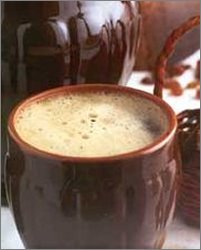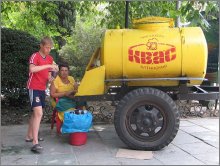Kvass: What is This Popular Russian Drink, Is It Good for You & Why is Coca-Cola Getting In the Act?
by www.SixWise.com
Kvass has been enjoyed in Russia for at least 1,000 years,
yet even today if you visit Russia during the summer months
you will see people lining up to get a cool glass of this
tangy beverage from a street vendor.
|

Many of the healthy properties of traditionally made
kvass come from the fermentation process.
|
Its mass appeal crosses generations, and even Western soda
producers are looking for a piece of the kvass pie.
Coca-Cola, which recognizes the potential of this ancient
beverage -- and is also surely aware that it represents the
fastest-growing segment of the Russian beverage market --
is even planning to introduce a kvass of its own called "Mug
and Barrel."
Kvass? Never Heard of It
Such is likely to be the response of most Americans when
asked about kvass. So what exactly is it?
Kvass is a fermented beverage made from stale dark, sourdough
rye bread. It's brown and bubbly, with a beer-like taste,
but its alcohol content is so low that it's considered non-alcoholic
(though it turns alcoholic if it's left to ferment long enough).
It may be flavored with herbs, strawberries, raisins, currants,
lemons, cherries, apples or mint.
Kvass is a staple
of Russia, enjoyed by czars to peasants and everyone in
between. Russian soldiers even used to drink a ladle full
of kvass before going out onto the streets of Moscow during
a cholera epidemic, according to Sally Fallon of the Weston
A. Price Foundation.
And because kvass has properties that protect against infectious
disease, there was no need to worry about sharing glasses.
Why Should I Drink Kvass?
Kvass in traditional form, if you can find it, is an extremely
healthy beverage. It is rich in B vitamins, thought to relieve
intestinal problems and hangovers. But more importantly, kvass
is fermented, which means it contains beneficial bacteria,
or probiotics, that are regarded as a digestive aid, and that
may destroy disease-causing microbes in your intestine.
Probiotics in fermented foods such as kvass have been the
topic of much research (and have spurred a host of new food
products like Dannon's Activia). Already, its been found that
probiotics may:
-
Enhance your immune system
-
Prevent infections after surgery
-
Treat acute and chronic diarrhea
-
Relieve inflammatory bowel disease
-
Treat irritable bowel syndrome (IBS)
-
Protect against cancer development and progression
Aside from the health benefits, the other reason why you
should drink kvass is for the taste. It's tangy and not too
sweet, and it's said to be among the best things on earth
to quench your thirst.
|

A street vendor sells kvass.
|
If you'd like to try out authentic kvass for yourself, you're
guaranteed a wide variety if you hop a plane to Russia. If
travel is not in your near future, you may be able to find
kvass in Russian specialty shops and grocers.
Please be careful, as some of the newer commercial varieties
contain preservatives and other chemical additives, and therefore
will not offer the same health impacts as traditional kvass.
Traditional kvass has a very short shelf-life, about a week
at room temperature and three weeks in the fridge. So if you
see kvass that can keep for longer than that, it's a pretty
good indication that it's not traditionally made.
Alternatively, you could try to make kvass at home. It's
an involved process, but well worth the effort. Here's a do-it-yourself
recipe from the Weston
A. Price Foundation:
Homemade Kvass
Ingredients:
- 1 pound rye bread, cut into 1/4-inch slices (it should
contain only rye flour, and no additives or preservatives)
- 1 1/2 cups sugar, in all
- 1 package dry active yeast
- 1 tablespoon unbleached white flour
- Filtered water
- About 1 dozen raisins
Method:
- Spread the bread on cookie sheets and bake for about 30
minutes at 325 degrees F. When cool, chop into 1/4-inch
pieces in a food processor.
- Bring 4 quarts of water to a boil and then cool to 175
degrees F. Add the bread, stir well, cover with a lid and
leave in a warm place (76-78 degrees F) for 1 hour. Strain
and reserve both the bread and the liquid.
- Bring another 2 1/2 quarts of water to a boil, cool down
to 175 degrees F and add the reserved bread. Cover with
a lid and leave in a warm place for 1 1/2 hours. Strain
and discard the bread. Combine both batches of liquid.
- Place 1/4 cup sugar and 1 tablespoon water in a small
cast-iron skillet. Stir continuously over heat until the
mixture turns golden brown. (Be careful not to burn it.)
Remove from heat and gradually blend in 1/2 cup of the reserved
liquid. Then stir this mixture into the entire batch of
liquid.
- In a small saucepan place 1 cup water and the remaining
1 1/4 cups sugar. Bring to a boil, lower the heat and simmer
for 10 minutes, skimming once or twice. Stir this syrup
into the reserved liquid and allow the mixture to come to
room temperature (about 75 degrees F).
- Mix the yeast with the flour and combine with 1 cup of
the liquid. Return this yeast mixture to the pot. Make an
X of masking tape across the top of the pot. Cover the pot
with 2 layers of cheesecloth or a clean kitchen towel and
leave in a warm place (73-78 degrees F) for 8-12 hours or
overnight. Cool the kvass to about 50-54 degrees F. Transfer
to bottles, seal tightly and refrigerate for 24 hours. The
kvass will keep in the refrigerator for 2-3 days.
Related Articles
The
Six Healthiest Staple Foods in Russian Cuisine
Eating
Raw: The Advantages and Disadvantages According to Various
Experts
Sources
The
Weston A. Price Foundation